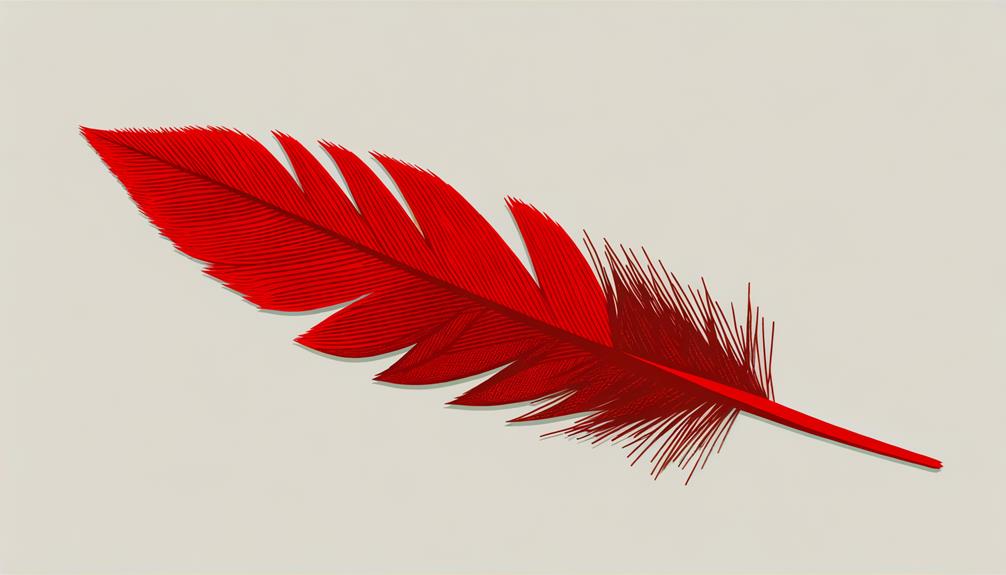7 Steps to Master Drawing a Cardinal Feather
To draw a cardinal feather, start by collecting sketching pencils, a kneaded eraser, and smooth drawing paper. Begin with studying the feather's structure, noting the central shaft and barbs.
Sketch an elongated oval with a central shaft line. Outline the primary and secondary barbs, maintaining symmetry.
Add texture details by drawing fine lines along the shaft, ensuring consistency. Use shading techniques to create depth, starting with lighter tones and advancing to darker shades.
Apply vibrant red hues by layering pigments and blending for a natural look. Continue with these refined details to bring your cardinal feather to life.

Key Takeaways
- Sketch the basic feather shape with an elongated oval and a central shaft line for symmetry.
- Draw primary and secondary barbs with evenly spaced, curving lines from the central shaft.
- Add texture details by sketching fine lines along the shaft and varying line weights for depth.
- Use shading techniques to create a three-dimensional effect, identifying the light source for accurate shadow placement.
- Layer red hues starting with lighter tones, blending gradually to achieve a natural color gradient.
Collect Your Materials
To commence your artistic journey of sketching a cardinal feather, gather top-notch materials such as sketching pencils, erasers, drawing paper, and colored pencils.
Select a variety of sketching pencils, from H for light lines to B for shading. A kneaded eraser is perfect for precision, allowing for gentle corrections without harming your paper.
Choose a smooth, acid-free drawing paper that offers a suitable texture for both graphite and colored pencil work. Colored pencils with vibrant pigments will assist you in capturing the vivid hues of a cardinal feather.
Having these quality materials will not only enhance your drawing experience but also guarantee that your final piece is both detailed and vivid. Your meticulous preparation establishes the groundwork for success.
Study the Feather
With your materials at the ready, closely examine the cardinal feather to understand its intricate patterns, textures, and vibrant colors.
Observe the feather's structure, noting the central shaft or rachis and how the barbs branch symmetrically from it, forming a sleek, cohesive shape.
Pay attention to the gradient of colors shifting from deep crimson to lighter hues, reflecting the feather's natural vibrancy.
Notice the delicate interlocking barbules that create a smooth surface, yet also allow for subtle texture variations.
Take time to appreciate the feather's fine details, such as subtle variations in shading and the gentle curve of its form.
This thorough examination will provide a solid foundation for accurately capturing the feather's essence in your drawing.
Sketch the Outline
To begin sketching the outline of your cardinal feather, first define its basic shape by lightly drawing an elongated oval, tapering towards the end.
Next, add a central shaft line running through the middle to serve as the feather's spine.
This foundational structure will guide you as you refine the feather's intricate details.
Define Feather's Basic Shape
Begin by lightly sketching the feather's central shaft, known as the rachis, to establish the fundamental structure of your cardinal feather. This central line will act as a guide for the overall shape and symmetry.
Next, draw a gentle, elongated oval around the rachis to outline the general form of the feather. This will serve as a framework for the vanes, or the feather's individual barbs. Guarantee the base of the feather is slightly wider, tapering gradually to a pointed tip, mimicking the natural design of a cardinal feather.
Keep your lines light and fluid to allow for adjustments. This foundational shape is essential to capturing the feather's elegant and distinctive appearance, setting the stage for more detailed work.
Add Central Shaft Line
Carefully draw a refined, continuous line down the center of your feather, solidifying the rachis and providing a clear guide for the feather's intricate details to follow.
This central shaft, or rachis, is essential as it anchors the structure of the feather, ensuring symmetry and balance. Begin at the base, extending the line smoothly to the tip, maintaining a steady hand to achieve a consistent thickness.
Ensure this line is neither too faint nor too bold, as it should blend naturally with subsequent lines. Utilize light strokes initially, allowing room for adjustments.
This foundational step will serve as your main reference point, making it easier to achieve the realistic, delicate appearance characteristic of a cardinal feather.
Add Main Quill
Position your pencil at the base of the feather and draw a straight, thin line extending upward to form the main quill, making certain it is centered and serves as the structural backbone of your cardinal feather. This line, often referred to as the rachis, is essential for maintaining the feather's symmetry and balance.
To enhance the precision and effectiveness of this step, consider the following guidelines:
- Steady Hand: Maintain a steady hand to make sure the quill is straight and evenly drawn.
- Consistent Pressure: Apply consistent pressure to achieve a uniform line thickness.
- Reference Image: Use a reference image of a cardinal feather for accuracy.
- Proportional Length: Ensure the quill's length is proportional to the overall feather size.
Draw Feather Barbs
To begin drawing the feather barbs, start by outlining the primary barb shape, ensuring they fan out symmetrically from the main quill.
Next, add secondary barb details to create a more realistic and intricate pattern.
Outline Primary Barb Shape
Begin by identifying the central shaft of the feather, as this will serve as the backbone from which the primary barbs extend. Carefully draw lines radiating from this central shaft, making sure they are evenly spaced and gradually curving outward. These lines will form the primary barbs, essential for capturing the feather's natural texture and structure.
- Symmetry: Maintain symmetry on both sides of the shaft to guarantee a realistic representation.
- Spacing: Keep the gaps between barbs consistent to mimic the feather's natural pattern.
- Length: Vary the size of the barbs slightly to add authenticity and avoid a rigid appearance.
- Angle: Adjust the inclination of each barb slightly as they extend from the shaft to create a flowing, organic look.
Add Secondary Barb Details
With the primary barbs in place, carefully draw finer lines branching off from each primary barb to create the intricate secondary barbs that add depth and realism to the feather.
Begin by lightly sketching multiple thin lines emerging from each primary barb at a slight angle. These secondary barbs should vary in length and spacing to mimic the natural irregularity found in real feathers.
Focus on creating a balanced yet organic appearance. Pay attention to the direction and flow of these lines to make sure they blend seamlessly with the overall structure.
Take your time with this step, as the delicate details will greatly enhance the authenticity of your cardinal feather, bringing your drawing closer to lifelike perfection.
Refine Feather Texture
Enhancing the feather texture involves meticulously refining the barbs to achieve a realistic and detailed representation. Begin by lightly sketching the individual barbs extending from the central shaft. Pay close attention to their natural curvature and spacing. Use varied line weights to simulate depth and dimension, ensuring a lifelike appearance.
- Consistency: Maintain a consistent direction for barbs while allowing slight natural variations.
- Layering: Add layers of barbs to create a sense of depth and richness.
- Detailing: Incorporate fine lines to represent the smaller, intricate structures of the feather.
- Shading: Apply subtle shading to accentuate the texture and give the feather a three-dimensional feel.
Define Feather Shape
To define the feather shape, start by sketching a smooth, elongated oval, which will serve as the central structure of the cardinal feather. This initial outline will guide the overall form and proportions.
Next, draw a gentle curve at the top end to indicate the quill's tip. At the opposite end, where the feather meets the bird, extend the oval slightly into a tapered point. This will represent the calamus or the feather's base. Confirm your lines are light and fluid, allowing for adjustments.
Add Texture Details
Now that the foundational shape is established, it's time to enrich your drawing by adding texture details to bring the cardinal feather to life. Focus on the subtle intricacies that define the feather's natural appearance.
Gently sketch fine lines along the shaft to mimic the feather's barbs. Enhance realism by varying the length and direction of these lines. Pay close attention to the following elements:
- Barbs: Draw fine, closely spaced lines extending from the shaft.
- Barbules: Add smaller, delicate lines branching from the barbs for intricate detail.
- Edge Fraying: Include slight irregularities at the feather's edge to depict wear and tear.
- Downy base: Illustrate a softer, fluffier texture at the feather's base to indicate its natural composition.
These details will markedly contribute to the feather's lifelike quality.
Shade the Feather
Frequently, the addition of shading can significantly enhance the depth and realism of your cardinal feather drawing. Begin by identifying the light source in your composition, as this will determine where shadows naturally fall.
Use a variety of pencils, from H for lighter tones to B for darker ones, to create gradual shifts. Apply the lighter tones first to establish a foundation, then layer darker shades to highlight the feather's curvature and texture. Blend gently with a blending stump or cotton swab to smooth changes.
Pay special attention to the quill, ensuring it casts a subtle shadow on the vane. This systematic approach to shading will bring your feather to life, imbuing it with a three-dimensional quality.
Add Red Hues
Begin by selecting a range of red hues, from deep crimson to lighter scarlet, to accurately capture the vibrant coloration of a cardinal feather. Using these colors will help bring your drawing to life.
Gradually layer the hues to create depth and texture, paying close attention to the natural gradation seen in actual feathers.
- Layering Technique: Start with the lightest shade and build up to the darkest, creating a smooth shift.
- Blending: Use a blending tool or your fingers to softly merge the hues, ensuring a natural look.
- Highlighting: Add lighter tones sparingly to mimic the way light interacts with the feather.
- Detailing: Use fine lines to replicate the intricate barbs and vane structures.
Final Touches
To perfect your cardinal feather illustration, focus on enhancing color vibrancy and adding fine details.
Begin by deepening the red hues to achieve a more lifelike appearance, utilizing layers of varying shades.
Next, incorporate subtle lines and textures to emulate the natural intricacies of a real feather, ensuring your drawing captures its delicate beauty.
Enhancing Color Vibrancy
Adding the final touches to enhance color vibrancy involves carefully layering pigments to achieve a rich, lifelike representation of the cardinal feather. Begin by choosing high-quality, saturated pencils or paints. Gradually build up the colors, starting with lighter hues and progressing to deeper tones. This method ensures a smooth progression and depth.
Blend carefully: Use a blending tool or brush to soften harsh lines, creating a smooth gradient.
Layer strategically: Apply multiple layers of color, allowing each to dry before adding the next.
Highlight judiciously: Add highlights with a white or lighter-colored pencil to mimic natural light.
Rectify mistakes with caution: Use an eraser or lifting technique to correct errors without damaging the underlying layers.
These techniques will bring your cardinal feather to life.
Adding Fine Details
Delicately refining the cardinal feather's intricate details enhances its realism and depth, capturing the essence of this beautiful bird.
Begin by using a fine-tipped pencil to outline the barbs and barbules, ensuring each line flows naturally from the quill to the edge. Varying the pressure will create a more dynamic texture.
Next, employ a white gel pen or fine eraser to add subtle highlights, mimicking the feather's natural sheen.
For the finishing touch, use a blending stump to softly blur areas where the barbs overlap, providing a realistic sense of layering.
Conclusion
To sum up, the process of sketching a cardinal feather involves a harmonious mix of attentive observation and precise technique. By gathering essential materials, examining the feather's anatomy, outlining, and methodically adding the shaft, filaments, patterns, shadowing, and vivid crimson tones, the artist can produce a realistic portrayal.
Each stage, akin to a stroke in a masterpiece, contributes to the ultimate detailed and engaging artwork. This organized method guarantees that the feather is depicted with both precision and creative style.






